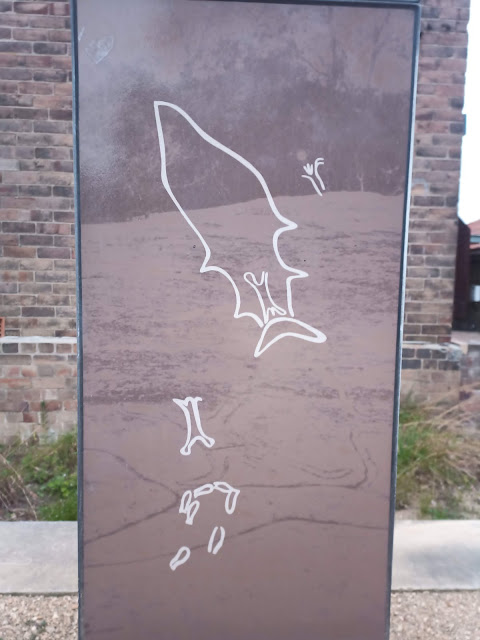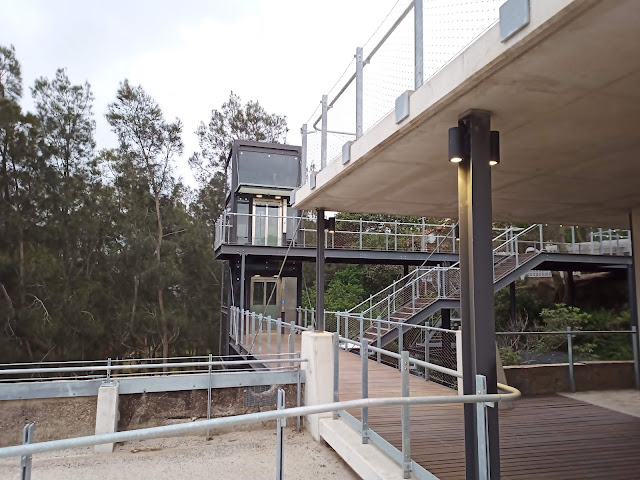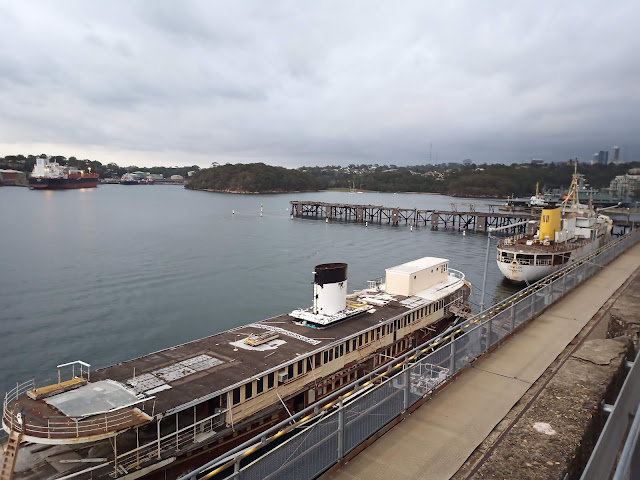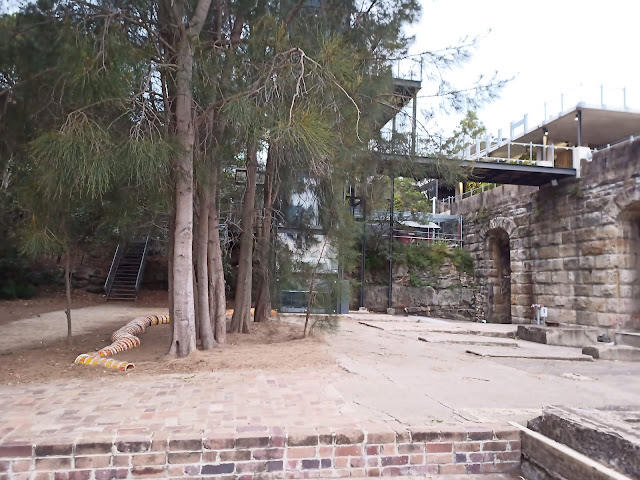The Coal Loader Site (Sydney, Australia)
The Coal Loader Centre for Sustainability is located in Waverton, a
suburb in Sydney’s north shore. Hidden away on the edge of the leafy
suburb’s residential area, this site uniquely blends reflection on and
conservation of the location's past with an active forward looking
approach to the future. Having returned to Sydney from my trip to India, I explored this site with fellow Sydney blogger and local celebrity Completing Sydney.
Upon first reaching the site at its northeast corner, a sign welcomes visitors to the Coal Loader site, leading down a short trail through a small patch of bushland to a boardwalk in front of a smoothed rock face. The sign includes details of native and introduced species found in this bushland, and leads to the first point of cultural significance. These native species were utilised for medicinal and food purposes by the local inhabitants of this region, the Cammeraygal people.
Archaeological works have also uncovered the presence of possible middens, which are occupation sites with remains of food sources such as shellfish and animal bones, as well as bone and stone tools (for another midden site visit, Boon Wurrung Shell Midden on Phillip Island).
As is the story with much of the Aboriginal cultural heritage within Australia, the rock engravings were recorded as early as 1840, but were not paid much attention at the time and were later covered up during building works by colonists. It was only in 2011 that the engravings were uncovered and the site planted with native flora in order to recognise the cultural significance of this place prior to the arrival of European settlers, and its continued importance to the Cammeraygal people long after this.
Of note is the fact that in the 1980s the rock carving was accentuated with white paint. Since then, the carving has been restored to its original condition, an interesting example of how our approach to preserving and displaying cultural heritage has changed in even a few short decades.
Just beyond this area, there are a couple of buildings, including the local headquarters of the North Sydney State Emergency Service opened in 2009, and an older brick building from the 1920s that was originally used as a mess hall with facilities for food and showering for Coal Loader workers. Since the coal loading operations ceased in 1992, the building has been repurposed for various uses by the Waverton community and since 2009 has been fitted out as a community booking hall.
The brick walls and metalwork that are found across the site are made from recycled or reused materials where possible, reducing the environmental impact from its construction.
So, after hearing the phrase "Coal Loader" a number of times by now, you're probably wondering what exactly a coal loader is. A number of signs at the site explain this quite well.
Here's some background. In the early 1800s the Aboriginal population experienced extreme suffering from disease and dispossession that accompanied European settlers. By the 1820s the entire Waverton Peninsula was given by the Crown to a colonist as a land grant, and in the early 20th century a number of industrial structures were built, including the Coal Loader site which was built in 1913 to 1920 and served as a storage and distribution point for coal. The former BP oil storage depot was also located here. As coal was the main energy source at this time, the historical context of the site in supporting colonial Sydney is quite notable. This industry also supported the growth of international trade, with ships delivering coal travelling from this point to harbours across the globe.
The Coal Loader site's caretaker cottage has since been converted into the main hub for the sustainability component of the site, containing resources, displays and facilities to promote sustainable living. The cottage has been refitted with solar power facilities, and makes use of natural lighting and recycled or renewable building materials. A small kitchen garden with herbs and fruit trees surrounds this building. Another nearby building is used as an artist's workspace to run workshops on the use of natural dyes and landscape painting using natural resources.
But the most eye catching part of the site lays beyond these few buildings. The main industrial component of the Coal Loader site has been turned into a huge open park space with grass and paved areas, plants, and benches next to a nice view of the harbour. The parkland occurs over three levels, all of which are accessible by ramps and lifts (the first being the area with the rock engraving and the caretakers cottage). Three huge glass panels on the second level down provide more information about the site, and along the edge of the water you can take a few steps down to a lower walkway to see the remains of one of the old wharves and a few historical ships. Platforms give views from each of the levels of the site, and you can even find a piano and stool waiting for passersby like yourself to play a few tunes.
The lift can take you down to the lowest level, level three from the top, and deposit you in a less developed area inside the bushland. Aside from a garden edging made from old street signs, are a number of tunnels that lead under the site. These were originally used to transport coal loading skips from one end of the site to the other, but today you can peek inside one of the tunnels to see one of the original skips on its rails. Another tunnel is open for pedestrian access, whilst still another is closed to the public as a population of microbats lives there now (according to the North Sydney council website!).
The middle tunnel is the path that I took. It turned out to be a bit damp, dimly lit, and full of pigeons, but I made my way through to the other end, which turns you out on the edge of Balls Head Reserve at a bushwalking path.
I followed this path around the reserve, and took in some amazing views of Sydney Harbour to top off this day of exploration. To see these views and learn more about the picturesque suburb of Waverton, head to Completing Sydney's Waverton article.
Tweet
Upon first reaching the site at its northeast corner, a sign welcomes visitors to the Coal Loader site, leading down a short trail through a small patch of bushland to a boardwalk in front of a smoothed rock face. The sign includes details of native and introduced species found in this bushland, and leads to the first point of cultural significance. These native species were utilised for medicinal and food purposes by the local inhabitants of this region, the Cammeraygal people.
This rocky sandstone platform bears rock carvings by the locals, displaying the outline of a large shark or whale. Although not easily visible to the eye, archaeological surveys carried out at this site have shown that this large creature is accompanied by engravings of fish, turtles, and mythological figures.
Archaeological works have also uncovered the presence of possible middens, which are occupation sites with remains of food sources such as shellfish and animal bones, as well as bone and stone tools (for another midden site visit, Boon Wurrung Shell Midden on Phillip Island).
As is the story with much of the Aboriginal cultural heritage within Australia, the rock engravings were recorded as early as 1840, but were not paid much attention at the time and were later covered up during building works by colonists. It was only in 2011 that the engravings were uncovered and the site planted with native flora in order to recognise the cultural significance of this place prior to the arrival of European settlers, and its continued importance to the Cammeraygal people long after this.
Of note is the fact that in the 1980s the rock carving was accentuated with white paint. Since then, the carving has been restored to its original condition, an interesting example of how our approach to preserving and displaying cultural heritage has changed in even a few short decades.
 |
| Wikimedia Commons https://commons.wikimedia.org/wiki/File:(1)Balls_Head002.jpg |
Just beyond this area, there are a couple of buildings, including the local headquarters of the North Sydney State Emergency Service opened in 2009, and an older brick building from the 1920s that was originally used as a mess hall with facilities for food and showering for Coal Loader workers. Since the coal loading operations ceased in 1992, the building has been repurposed for various uses by the Waverton community and since 2009 has been fitted out as a community booking hall.
The brick walls and metalwork that are found across the site are made from recycled or reused materials where possible, reducing the environmental impact from its construction.
So, after hearing the phrase "Coal Loader" a number of times by now, you're probably wondering what exactly a coal loader is. A number of signs at the site explain this quite well.
Here's some background. In the early 1800s the Aboriginal population experienced extreme suffering from disease and dispossession that accompanied European settlers. By the 1820s the entire Waverton Peninsula was given by the Crown to a colonist as a land grant, and in the early 20th century a number of industrial structures were built, including the Coal Loader site which was built in 1913 to 1920 and served as a storage and distribution point for coal. The former BP oil storage depot was also located here. As coal was the main energy source at this time, the historical context of the site in supporting colonial Sydney is quite notable. This industry also supported the growth of international trade, with ships delivering coal travelling from this point to harbours across the globe.
The Coal Loader site's caretaker cottage has since been converted into the main hub for the sustainability component of the site, containing resources, displays and facilities to promote sustainable living. The cottage has been refitted with solar power facilities, and makes use of natural lighting and recycled or renewable building materials. A small kitchen garden with herbs and fruit trees surrounds this building. Another nearby building is used as an artist's workspace to run workshops on the use of natural dyes and landscape painting using natural resources.
But the most eye catching part of the site lays beyond these few buildings. The main industrial component of the Coal Loader site has been turned into a huge open park space with grass and paved areas, plants, and benches next to a nice view of the harbour. The parkland occurs over three levels, all of which are accessible by ramps and lifts (the first being the area with the rock engraving and the caretakers cottage). Three huge glass panels on the second level down provide more information about the site, and along the edge of the water you can take a few steps down to a lower walkway to see the remains of one of the old wharves and a few historical ships. Platforms give views from each of the levels of the site, and you can even find a piano and stool waiting for passersby like yourself to play a few tunes.
The lift can take you down to the lowest level, level three from the top, and deposit you in a less developed area inside the bushland. Aside from a garden edging made from old street signs, are a number of tunnels that lead under the site. These were originally used to transport coal loading skips from one end of the site to the other, but today you can peek inside one of the tunnels to see one of the original skips on its rails. Another tunnel is open for pedestrian access, whilst still another is closed to the public as a population of microbats lives there now (according to the North Sydney council website!).
The middle tunnel is the path that I took. It turned out to be a bit damp, dimly lit, and full of pigeons, but I made my way through to the other end, which turns you out on the edge of Balls Head Reserve at a bushwalking path.
I followed this path around the reserve, and took in some amazing views of Sydney Harbour to top off this day of exploration. To see these views and learn more about the picturesque suburb of Waverton, head to Completing Sydney's Waverton article.
Tweet

















Comments
Post a Comment